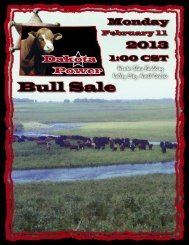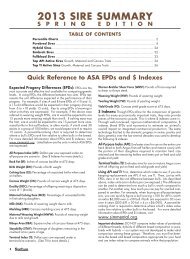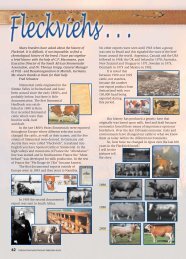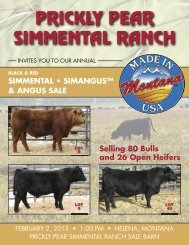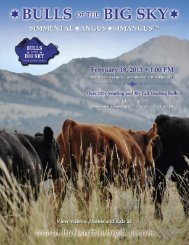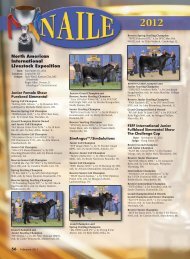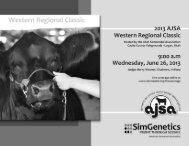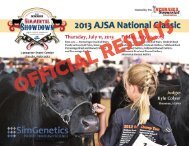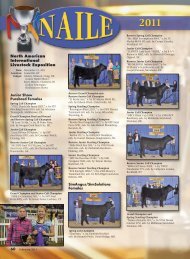It Has to Make Economic Sense Tom Murray
It Has to Make Economic Sense Tom Murray
It Has to Make Economic Sense Tom Murray
You also want an ePaper? Increase the reach of your titles
YUMPU automatically turns print PDFs into web optimized ePapers that Google loves.
<strong>Tom</strong> <strong>Murray</strong>, owner of Big Branch Simmentals<br />
and Big Branch Breeder’s Service, lives in the<br />
Avilla community, 20 minutes west of Little Rock.<br />
He is, like most people, not bashful when asked<br />
about his <strong>to</strong>pics of interest and experience, primarily<br />
herd efficiency and reproductive management.<br />
“If it makes economic sense, then let’s do it. If<br />
the math doesn’t make sense, then let’s just drop<br />
it,” he says. “That’s the bot<strong>to</strong>m line foundation of<br />
the various businesses that I have been involved<br />
with over the years.”<br />
A native of Indiana, <strong>Murray</strong> graduated from<br />
Valparaiso Technical Institute and immediately went<br />
<strong>to</strong> work for Texaco, performing seismograph work<br />
and maintaining electronic equipment. His duties<br />
required him <strong>to</strong> travel extensively throughout the<br />
US and in<strong>to</strong> several foreign countries. His first trip<br />
was <strong>to</strong> El Dorado, Arkansas, where he met his<br />
future wife, Elene, married her and started a family.<br />
After 16 years with the company, his family grew<br />
tired of their frequent moves and constant travel. “I<br />
resigned from Texaco and knew I had <strong>to</strong> find something<br />
else <strong>to</strong> do since I had a wife and three children<br />
12 May/June 2013<br />
By Dan Rieder<br />
Arkansas breeder <strong>Tom</strong> <strong>Murray</strong>’s<br />
approach <strong>to</strong> business is based on a<br />
philosophy of sound economics.<br />
<strong>Tom</strong> and Elene <strong>Murray</strong>.<br />
Pho<strong>to</strong> by Alex Kent, Sherwood, AR<br />
by then,” he explained. “<strong>It</strong> was always our dream <strong>to</strong><br />
live in the country, <strong>to</strong> farm and be as self-sufficient<br />
as we could be, raising our own vegetables and<br />
meat. So in 1985, we started with 15 acres and a<br />
few commercial cows.”<br />
At that time, with no trash pick-up in a large<br />
portion of the county, folks were hauling their<br />
garbage in<strong>to</strong> the woods and disposing of it by dumping<br />
it in<strong>to</strong> county-sanctioned holes in the ground.<br />
Occasionally, the county would bring in heavy<br />
equipment and cover it up. When the Arkansas<br />
Pollution Control & Ecology Department began <strong>to</strong><br />
heavily fine the county for that practice, the <strong>Murray</strong>s,<br />
who are environmentally aware, saw an<br />
opportunity and started Big Branch Waste Management<br />
on a shoestring. “We stayed in that business<br />
for 10 years, expanding from two cus<strong>to</strong>mers <strong>to</strong><br />
several thousand — utilizing a number of big<br />
commercial trucks, and provided the only recycling<br />
pickup in the county,” said <strong>Murray</strong>.<br />
“After some time passed, we received an offer<br />
that was <strong>to</strong>o good <strong>to</strong> pass up and we sold the business.<br />
<strong>It</strong> was time <strong>to</strong> focus on our farm and family.”
Moving Forward<br />
<strong>Murray</strong> jumped in<strong>to</strong> cattle breeding with both feet. “By then, I had<br />
established my Simmental cow herd. I’d read about the breed and I<br />
liked all of their characteristics. I eliminated the few cows I’d had<br />
from another Continental breed. Those cows would put you right up<br />
in the back of your truck,” he said.<br />
“That was at the height of the big exotic cattle era, they were all<br />
spotted and tall enough <strong>to</strong> walk over the <strong>to</strong>p of a five-wire barbed<br />
wire fence,” he laughed. “Then, I ran in<strong>to</strong> Dr. Robert Messer of Texas.<br />
He convinced me <strong>to</strong> purchase my first Fleckvieh cow. I really didn’t<br />
know what I was doing, but she proved herself <strong>to</strong> be awesome and<br />
made a Simmental believer out of me. She was a little yellow cow that<br />
weighed 1,100 pounds and weaned off blocky, 700-pound calves.”<br />
<strong>Murray</strong> continued <strong>to</strong> build his herd with Messer genetics. “I bought<br />
several females from him, and before long, my herd was all Fleckvieh.<br />
Even <strong>to</strong>day, my best cows can be traced back <strong>to</strong> his cattle. I still love<br />
the Fleckvieh, but now we’re breeding a few <strong>to</strong> red and black purebred<br />
bulls,” he added.<br />
“I really like those Fleckvieh-purebred cross calves. I believe that<br />
we get some within-breed heterosis out of that combination, and<br />
they are very marketable. The commercial cattlemen around here<br />
are mostly breeding Angus with a few Herefords, but they are coming<br />
<strong>to</strong> realize that they need <strong>to</strong> get away from straightbreds. These halfblood<br />
bulls are in high demand,” he said.<br />
Before the record-breaking drought of the past few years, <strong>Murray</strong><br />
had built his herd <strong>to</strong> 50 head, but has been forced <strong>to</strong> cut back <strong>to</strong> their<br />
present level of 35 cows due <strong>to</strong> the resulting shortage of grass. He<br />
plans <strong>to</strong> rebuild when climatic conditions permit.<br />
For the past decade or more, he has had a contractual relationship<br />
with Laura’s Lean Beef, based out of Lexing<strong>to</strong>n, Kentucky. “Laura’s<br />
focuses on Continental, heavy-muscled, lean cattle breeds including<br />
Simmental, Charolais, Limousin and Gelbvieh. <strong>It</strong>’s a branded market<br />
and they do pay a premium for all natural — no hormones, or antibiotics”<br />
he says.<br />
“They’ll take intact bulls, cows, heifers or steers. The steers and<br />
heifers we don’t keep are marketed through Laura’s Lean Beef. We<br />
sell a few breeding bulls and heifers, but I haven’t been selling a lot<br />
of breeding s<strong>to</strong>ck lately since I’ve had so much success selling <strong>to</strong><br />
Laura’s Lean Beef. I’ve gone right <strong>to</strong> market with 700-pound calves.<br />
<strong>It</strong>’s a relationship that works,”<br />
says <strong>Murray</strong>.<br />
<strong>Murray</strong> and several of his<br />
neighbors who also produce<br />
Simmental genetics, combine<br />
their cattle <strong>to</strong> assemble a truckload<br />
for Laura’s Lean Beef.<br />
“Laura’s comes down here <strong>to</strong><br />
our fairgrounds, weighs them,<br />
and loads them up. That way,<br />
they pick up quite a few head<br />
with just one s<strong>to</strong>p.”<br />
<strong>Murray</strong> (fifth from the left in the front<br />
row) with one of his AI clinics.<br />
Serving the Industry<br />
Big Branch Breeder’s Service, a company<br />
he formed several years after selling the<br />
waste management business, is also named<br />
after Big Branch Creek, the stream that flows<br />
through the farm.<br />
<strong>Murray</strong> has been an Artificial Insemination<br />
Representative for an extended period,<br />
first with Genex and Accelerated Genetics,<br />
then, for the past 10 years with ABS Global<br />
as their representative for the state of<br />
Arkansas. “Big Branch Breeder’s Service is<br />
a full-service company; we supply semen<br />
and liquid nitrogen for A.I. tanks, conduct<br />
instructional clinics, and breed cows for<br />
our clients,” he said.<br />
“We employ two men full time, in addition<br />
<strong>to</strong> ourselves. We are the largest provider<br />
of liquid nitrogen, semen, and breeding<br />
service <strong>to</strong> Arkansas’ cattle people. Most cattlemen<br />
in this area have only 20 cows, and<br />
may not want <strong>to</strong> own a bull. They also want<br />
<strong>to</strong> use the best genetics available. Those are<br />
a couple of areas where producers find our<br />
Artificial Insemination and Reproductive<br />
Management Clinics helpful. We hold two<br />
or three sessions a year, try <strong>to</strong> keep it as<br />
simple as possible, and end up training 35<br />
<strong>to</strong> 40 people a year,” he says. “Our crew<br />
also breeds thousands of head each year<br />
for our clients.”<br />
Big Branch Breeder’s Service goes one<br />
step further, assisting their clients in selling<br />
their bred heifers. “We add value <strong>to</strong> our<br />
breeding projects by working with producers<br />
<strong>to</strong> market their A.I. bred heifers through an<br />
AI-bred heifer sale at the larger sale barns.<br />
This added value has proven <strong>to</strong> be a great<br />
incentive,” he advised.<br />
(Continued on page 14)<br />
May/June 2013 13
(Continued from page 13)<br />
Their farm is the family hub with four<br />
generations currently residing in the valley.<br />
Land owned by his parents, Eric and Lucy,<br />
<strong>to</strong>uches the eastern boundary of the farm.<br />
They moved south from Indiana after Eric,<br />
a British immigrant, concluded a career with<br />
Uniroyal. Lucy was a nurse and <strong>to</strong>gether,<br />
they had four sons.<br />
Residing on the northwestern perimeter<br />
is their son, Andy, and his wife, Ginna, and<br />
their two boys, Drew, 11 and Matt, 10. Andy<br />
works for Harris Electronics, maintaining<br />
telecommunications systems, while Ginna<br />
owns a speech pathology clinic, Therapy<br />
Providers, PA.<br />
Daughter, Emily Norman, an adjunct<br />
instruc<strong>to</strong>r at a local college, is a middle<br />
school teacher-turned-stay-at-home mom,<br />
keeping an eye on Joseph, 2, and 10-monthold<br />
baby, Elizabeth. Her husband, Jonathan,<br />
14 May/June 2013<br />
Hands-on experience is available <strong>to</strong> all AI class participants.<br />
<strong>Murray</strong> is second from the right.<br />
is a computer programmer for Southwest Power Pool. They, live<br />
on the northern perimeter of the farm on their own six acres.<br />
Tragically, the baby of <strong>Tom</strong> and Elene’s family, 12-year-old<br />
<strong>Tom</strong>my, was killed in a traffic accident 19 years ago.<br />
“I wasn’t raised in agriculture, but I made a conscious decision<br />
<strong>to</strong> get in<strong>to</strong> it. Elene and I like the idea of being as self-sufficient as<br />
possible,” he concluded. “We continue <strong>to</strong> believe that if something<br />
makes sense economically, we’ll go for it.” ◆




